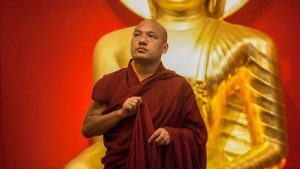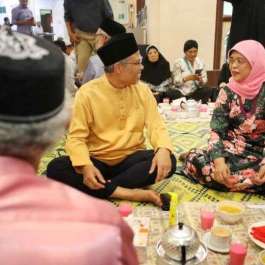I was fortunate to attend this exhibition at the renowned Whitney Museum of American Art in New York City at the end of November, to drink in multimedia works from a choreographer and dancer I have long admired: Alvin Ailey and his American Dance Theatre. The show is replete with paintings, sculptures, prints, photographs, videos, and more from decades of vital dance heritage, including notes and drawings from Ailey’s own journals.
My parents both grew up in southern parts of the United States—Texas and the Southern seaboard, respectively. Both were children of military parents. My mom stayed put in San Antonio, while my father moved between various states, including Georgia, Maryland, Virginia, Florida, and Tennessee. They were to meet at the American High School in Paris in 1955. Both were musicians and singers and both appreciated dance and the arts in general as they matured into young adults. My parents grew up in the era of Jim Crow, segregation, and racial violence. They eventually settled in the Northeast, where education was more progressive but racism still reigned. I was raised in a climate of tolerance, justice, and sharing knowledge toward diminishing bias and discrimination. My own elementary school participated in desegregation efforts, having Black and other marginalized students bused in from inner-city Boston. Tensions were high, as I recall.
As a Buddhist adult, I have written more than once about the need to understand spiritual practice and social justice efforts as one movement —not two. We can only be as free and liberated as the rest of humanity, as it is a group effort and a collective project, at least if we are Mahayana or Vajrayana practitioners. As Berkeley Zen Center abbot Hozan Alan Senauke writes:
When we respond to another on the basis of color, caste, or gender, then according to the Buddha’s teachings and lessons of biology and social science, we are acting from the delusion of unconscious bias “inculcated unconsciously into us early in life.” Usually, there are some elements of fear and self-protection in these views. The point of Buddhism is to see the workings of our mind, transforming delusion and habit into enlightened activity for the benefit of all beings. That work proceeds from the inside out and from the outside in. That is, introspection and meditation transform our work in the world; and worldly endeavors affect our beliefs, thoughts, and self-awareness.*
As one of my Buddhist teachers states, “Only a healthy ego can be liberated.” We tend to think largely of our own liberation, but if the bodhisattva vow is to empty samsara of all suffering, then doesn’t it stand to logic that we are practicing for the liberation and relative freedom of all beings? I do not think this is a stretch. I only find that particularly as white Western Buddhists we may not make the effort to include beings less fortunate in our outward actions, through engaged Buddhism, speaking up, or advocating for much-needed change to ensure freedoms for all.
Art, music, dance, and film serve to express and share voices that may be less likely heard through media. They are ideal for shining a light on injustices and individual and societal needs in effective, often uplifting, and inspiring ways. Dance has always been this medium for me. In college, I practiced Afro-Haitian and West African dance with various groups, feeling the stirring of joy and connection that I had first experienced as a young teen traveling through small villages in East Africa. There, our only common language was song and dance.
Growing up witnessing civil rights and racial violence in Massachusetts, the brutality of South African apartheid on TV, and everyday racism in my schools led me toward embodying antiracist work as an adult. And while it is not enough for my liking as a Buddhist, it feels hypocritical to live in the US to not be more involved. We all do what we can, but social justice work is never done.
Edges of Ailey, which opened at the Whitney Museum of American Art on 25 September, is the first large-scale museum exhibition to celebrate the life, dances, influences, and enduring legacy of visionary artist and choreographer Alvin Ailey (b. 1931, Rogers, Texas; d. 1989, New York City). This dynamic showcase—described as an “extravaganza” by curator Adrienne Edwards—brings together visual art, live performance, music, a range of archival materials, and a multi-screen video installation. I highly recommend making an effort to see it.
I grew up hearing gospel on LPs and spirituals sung in the home, and I was exposed to Black culture and the arts through my public schooling in suburban Boston. In college, I studied African art and dance, moved by the polyrhythms, complexity, and depth of spiritual feeling previously unknown to me in an agnostic household. Music was the closest we came to religion in the home and it fed me. My grandparents lived in the rural South, no doubt complicit in a racist society.
Although Ailey built a multiracial dance company, dedicated to expansion, the content and styles were drawn from a wealth of black cultural forms, such as the blues, jazz, and many others. His work, and that of his incredible company, which continues to thrive to this day, drew from a rich heritage, and propelled black futurism through dance and the arts well into the future for generations:
Ailey’s interest in the ecstatic aspects of spiritual experience also went beyond the Black church of the American South. Like anthropologist and choreographer Katherine Dunham, who was a practitioner of Haitian vodou, he found special resonance in Brazilian candomblé, an African diasporic religion that combines spiritual influences from West Africa—including the Fon, Yoruba, and Bantu—with Roman Catholicism. The particular songs, devotional rituals, ways of moving, and distinct garb associated with candomblé and vodou exemplified endurance, imagination, and sociality in contrast to extreme subjugation. (Whitney Museum of American Art)
The art presented in Edges of Ailey is beyond inspiring, a truly rich collection of works of many fine, famous, and lesser-known artists including Romare Bearden, Jacob Lawrence, and Faith Ringgold.
Faith Ringgold is featured in this show, with several of her large-scale fabric art pieces, gorgeously presenting the harsh realities of Black and Indigenous suffering in these so-called United States. Her art, and that of the many featured creators, stands through decades as a testament to the trials, suffering, and resilience on the oath of Black liberation and therefore of the liberation we all strive for and for one another. May all beings be free to embody and express their unique beauty and be liberated from all cycles of suffering.
* Is This Buddhism? The Oneness of Spiritual Liberation and Social Justice (BDG)
See more
Alvin Ailey (Whitney Museum of American Art)
Edges of Ailey (Whitney Museum of American Art)
Alvin Ailey: Grace by Ronald K Brown (YouTube)
Related features from BDG
Indigenous Haute Couture and Art: Tradition Meets Futurism in the Exquisite Creations of Jamie Okuma
Buddhistdoor View: Finding the Right Balance with Social Justice Causes
Restoration and Justice: An Interview with Dr. Natalie Avalos on Indigenous Spirituality and Buddhist Allies
Lama Rod Owens on Social Justice, Rest, and Resilience
Conscientious Compassion—Bhikkhu Bodhi on Climate Change, Social Justice, and Saving the World




















